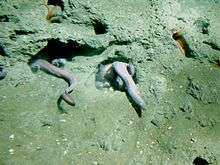Pacific hagfish
| Pacific hagfish | |
|---|---|
 | |
| Scientific classification | |
| Kingdom: | Animalia |
| Phylum: | Chordata |
| Class: | Myxini |
| Order: | Myxiniformes |
| Family: | Myxinidae |
| Genus: | Eptatretus |
| Species: | E. stoutii |
| Binomial name | |
| Eptatretus stoutii (Lockington, 1878) | |
| Synonyms | |
|
Bdellostoma stoutii Lockington, 1878 | |
The Pacific hagfish (Eptatretus stoutii) is a species of hagfish. It lives in the mesopelagic to abyssal Pacific ocean, near the ocean floor. It is a jawless fish and has a body plan that resembles early paleozoic fish. They are able to excrete prodigious amounts of slime in self-defense.
Description
The Pacific hagfish has a long, eel-like body, but is not closely related to eels. Maximum body lengths of 63 cm have been reported; typical length at maturity is around 42 cm. It is dark brown, gray or brownish red, often tinted with blue or purple. The belly is lighter and sometimes has larger white patches. It has no true fins, but there is a dorsal fin-fold. The head, as in all agnathans, does not have jaws, and the sucker-like mouth is always open.[2]
Hagfish have loosely fitting, slimy skins, and are notorious for their slime-production capability. When disturbed, they ooze proteins from slime glands in the skin that respond to water by becoming a slimy outer coating, expanding into a huge mass of slime. This makes the fish very unsavory to predators, and can even be used to clog the gills of predatory fish. Pacific hagfish can create large amounts of slime in just minutes.[3] The slime is notoriously difficult to remove from fishing gear and equipment, and has led to Pacific fishermen bestowing the nickname of 'slime eel' on the species.[4]
Distribution and habitat
The Pacific hagfish occurs in the Eastern North Pacific from Canada to Mexico. It inhabits fine silt and clay bottoms on the continental shelves and upper slopes at depths from 16-966 m. The species appears to be abundant within its range.[1]
Diet

While Pacific hagfish likely take polychaete worms and other invertebrates from the sea floor, they are also known to enter dead, dying or inhibited large fish through the mouth or the anus, and feed on their viscera.[2] The Pacific hagfish's skin can absorb nutrients, which has been demonstrated in the laboratory by showing the passage of amino acids through hagfish skin.[5]
The diet of other hagfish species includes shrimps, hermit crabs, cephalopods, brittlestars, bony fishes, sharks, birds and whale flesh, [6] but specific information about the Pacific hagfish is lacking.
Procreation
Hagfish fertilise their eggs externally after the female has laid them. On average females lay about 28 eggs, abount 5 mm in diameter, which are carried around after they have been fertilised. Females will however try to stay in their burrows during this period to ensure the protection of their eggs.[7]
Use by humans
There is a well-developed hagfish fishery on the US West Coast that mostly supplies the Asian leather-market. Hagfish-skin clothing, belts, or other accessories are advertised and sold as "yuppie leather" or "eel-skin"[7][1]
References
- 1 2 3 Mincarone, M.M. (2013). "Eptatretus stoutii". IUCN Red List of Threatened Species. IUCN. 2013: e.T196044A8997397.
- 1 2 Froese, Rainer and Pauly, Daniel, eds. (2015). "Eptatretus stoutii" in FishBase. 12 2015 version.
- ↑ Zintzen, V.; Roberts, C. D.; Anderson, M. J.; Stewart, A. L.; Struthers, C. D.; Harvey, E. S. (2011). "Hagfish predatory behaviour and slime defence mechanism". Scientific Reports. 1. doi:10.1038/srep00131.
- ↑ Theisen, Birgit. "The Olfactory System in the Pacific Hagfishes Eptatretus stoutii, Eptatretus deani, and Myxine circifrons.". Blackwell publishing. Retrieved 6 December 2011.
- ↑ Bucking, Carol. "Digestion under Duress: Nutrient Acquisition and Metabolism during Hypoxia in the Pacific Hagfish.". Retrieved 6 December 2011.
- ↑ Zintzen, V.; Rogers, K. M.; Roberts, C. D.; Stewart, A. L.; Anderson, M. J. (2013). "Hagfish feeding habits along a depth gradient inferred from stable isotopes" (PDF). Marine Ecology Progress Series. 485: 223. doi:10.3354/meps10341.
- 1 2 Barss, William (1993), "Pacific hagfish, Eptatretus stouti, and black hagfish, E. deani: the Oregon Fishery and Port sampling observations, 1988-92", Marine Fisheries Review (Fall, 1993), retrieved April 21, 2010
External links
 Media related to Eptatretus stoutii at Wikimedia Commons
Media related to Eptatretus stoutii at Wikimedia Commons
